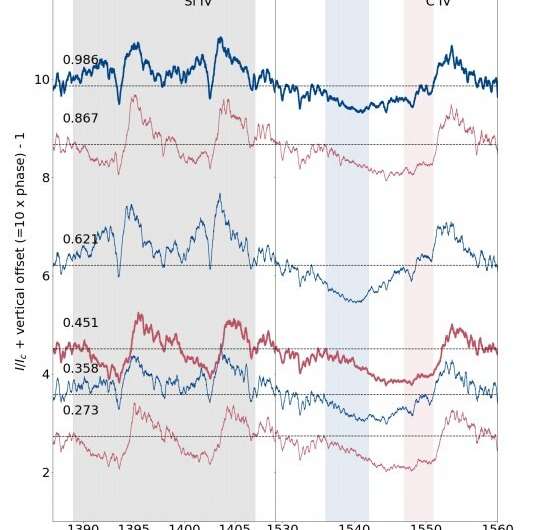October 21, 2020 report
NGC 1624-2 has a complex magnetospheric structure, observations reveal

Using the Hubble Space Telescope (HST) and Canada-France-Hawaii Telescope (CFHT), astronomers have investigated a magnetized O-type star known as NGC 1624-2. Results of the study, presented in a paper published October 15 on the arXiv pre-print server, indicate that the star has a complex magnetospheric structure, what could have implications for our understanding of origin and evolution of magnetic fields in massive stars.
O-type stars are massive, luminous, blue stars of spectral type O. Astronomers are especially interested in finding and studying O stars exhibiting a detectable surface magnetic field. These objects could be progenitors of exotic objects and transients such as heavy stellar-mass black holes and pair instability supernovae, as well as magnetars.
NGC 1624-2 is the most strongly magnetized O-type star known to date. Previous observations that this star is surrounded by a giant magnetosphere that must be large and dense, as it absorbs up to 95 percent of the intrinsic circumstellar X-ray emission.
In order to get more insights into the powerful magnetosphere of NGC 1624-2, a team of astronomers led by Alexandre David-Uraz of University of Delaware in Newark, investigated this star using ultraviolet spectra from HST and spectropolarimetric observations conducted with CFHT.
The study found that NGC 1624-2 hosts a large and dense circumstellar magnetosphere with a complex structure. The line profile variations observed in the obtained spectra are different than those usually seen in other typical magnetic O-type stars, where the magnetosphere is formed by the interaction of a strong stellar wind and a global dipolar field.
"Instead, the observed line profiles appear to exhibit one of two morphologies, previously understood ... to correspond to either a magnetic pole-on or magnetic equator-on view of the magnetosphere," the astronomers explained.
The researchers excluded other possible hypotheses that could explain the observed line profile variations such as an error in the determination of the rotation period and short-term stochastic variations. Therefore, they concluded that NGC 1624-2's magnetosphere is likely more structured than previously assumed, and that its surface magnetic field might depart from a dipolar geometry.
According to the authors, the results of the study have implications for our understanding of the population of O-type stars in general. The findings suggest that the strongest field detected at the surface of an O-type star is also topologically complex.
"The perspective of the strongest known magnetic field on an O-star also being topologically complex provides us with crucial information regarding the formation and evolution of such fields on massive stars and further emphasizes the singular importance of this archetypal object," the scientists noted.
They added that further studies, including better spectropolarimetric phase coverage and surface mapping techniques such as Zeeman Doppler Imaging, are required to shed more light on the complex magnetosphere of NGC 1624-2.
More information: David-Uraz et al., New observations of NGC 1624-2 reveal a complex magnetospheric structure and underlying surface magnetic geometry, arXiv:2010.07482 [astro-ph.SR] arxiv.org/abs/2010.07482
© 2020 Science X Network





















